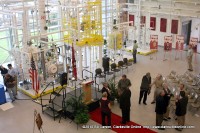 Austin Peay State University held a ribbon cutting for its new Chemical Engineering Technology Facility yesterday. The facility which has been designated the Hemlock Semiconductor Building will train Austin Peay Students to fill the skilled labor needs for the new Polysilicon plant being built in North Clarksville. The ribbon cutting was attended by area dignitaries along with HSC officials, and was open to the general public.
Austin Peay State University held a ribbon cutting for its new Chemical Engineering Technology Facility yesterday. The facility which has been designated the Hemlock Semiconductor Building will train Austin Peay Students to fill the skilled labor needs for the new Polysilicon plant being built in North Clarksville. The ribbon cutting was attended by area dignitaries along with HSC officials, and was open to the general public.
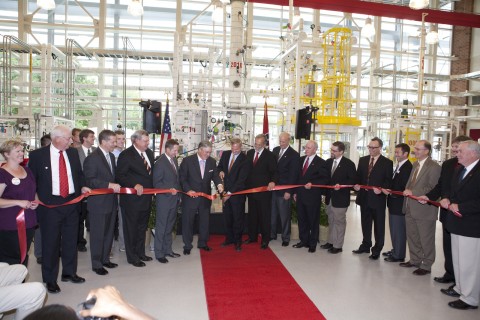
Located at the Intersection of 8th and College street the building was made possible by a contribution of 6.4 million dollars from the State of Tennessee, and a donation of 2 million dollars of equipment by Hemlock Semiconductor Corporation and its parent company Dow Corning. The building features a central lab area that is bordered by 4 classrooms. APSU President Tim Hall joked “I was surprised that Dr Little let us in here without steel toed shoes, thats normally his policy. But we have been given a rare dispensation”.
There are already 173 declared majors in the Chemical Engineering Technology Program. 4 of those being Freshmen. “We are expecting about 60 graduates from the first class in May 2011, and another 15 in August 2011,” said Chancellor Charles Manning of the Tennessee Board of Reagents.
[youtube]http://www.youtube.com/watch?v=4HAuz2tisNA[/youtube]
Many of the speakers commented on how rare it was for the construction of a facility of this magnitude to move ahead so quickly.
“Ultimately this facility is directly responsible to the State’s contribution of 6.4 million dollars, to build this thing, and to build it quickly, so that we would be able to produce graduates in time, that Hemlock would be able to consider them as employees of their new plant.” said President Hall who served as the emcee of the ceremony.
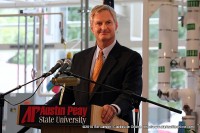
Hemlock President and CEO Rick Doornbos said “”It’s hard to believe that it was just 14 months ago we were standing right in a parking lot at the groundbreaking ceremony, and now we are surrounded by this beautiful state of the art facility, and we are especially honored that this new Chemical Engineering Technology Facility bears our company name.”
Clarksville Mayor Johnny Piper spoke about how our city and counties ability to partner with industry has people talking all around the state. “I am excited today about the future of Clarksville. I am excited about the direction we are taking. As I am around the community and frankly throughout the state, I hear people talking about the positive things happening in Clarksville, Tennessee. You should be proud of of what’s happening and excited about the future. This building is part of that future, and Hemlock Semiconductor is part of that future.”
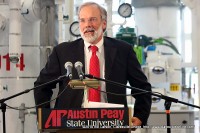
Deputy Governor John Morgan, the Chancellor elect of the Tennessee Board of Regents talked about forging a new path forward in education with a focus on partnering with industry to meet their skilled workforce needs. “This is a remarkable building, it’s a remarkable building because it’s a remarkable building, but also for what it represents. It represents partnerships in a way that we haven’t seen much of in the past in Tennessee. Partnerships between the state and Hemlock Semiconductor; and the city of Clarksville, the county of Montgomery. Partnerships among and between industry, and community, and educational institutions, in a way that really shows us the way forward, I believe, as we struggle in Tennessee with really unprecedented fiscal challenges, as we try to figure out how we are going to educate Tennesseans, how we are going to respond to the neeeds of industry, how we are going to create jobs, how we are going to improve the quality of life for Tennesseans.”
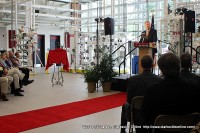
This sentiment was echoed in Doornbos statement, “We are at the dawn of yet another new beginning right here in Clarksville/Montgomery County. This tremendous achievement and milestone would not have been possible if it weren’t for the strong collaboration between private and public sectors.This great public university along with the State of Tennessee has successfully partnered with private business to provide today’s students the tools, training, and skills they will need to invent tomorrow.”
Several of the speakers spoke on the milestones that this project had to reach to be able to get to this point. “This is really a milestone. The part I would emphasize more than anything else is that this is really the fulcrum of a point of leverage for Austin Peay, for this community, for the state, for Hemlock. It’s the kind of thing that higher education institutions can be a really be major part of in a community, especially as the intellectual content of jobs continues to increase the education needed to do it.” said Manning in his remarks.
To view what’s going on at the Hemlock Semiconductor Building view their web cam.
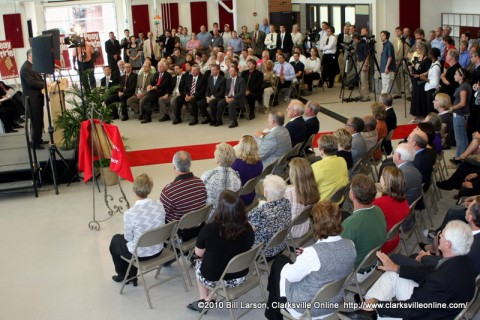
Hemlock Semiconductor Building (HSB) at Austin Peay State University
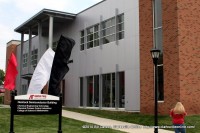
- The building initially was called the Chemical Engineering Technology Facility. In June 2010, the Tennessee Board of Regents approved President Tim Hall’s recommendation to name the facility in honor of Michigan-based Hemlock Semiconductor Group for its $2 million gift to APSU for the purchase of laboratory equipment for the building. The contribution was one of the largest monetary gifts ever given to APSU.
- The Hemlock Semiconductor, L.L.C. facility in Clarksville will manufacture solar grade polycrystalline silicon. Hemlock Semiconductor is a leading provider of polycrystalline silicon and other silicon-based products used in the manufacturing of semiconductor devices and solar cells and modules. APSU felt it was important to incorporate solar panels into the design of the building. Solar panels were used as the key component of the building for aesthetic, functional and educational reasons.
- The tower also features a skin of solar panels as well as sundial to provide a “solar” clock tower. This uniquely appropriate element provides an iconic feature at this entry to the campus and contributes to the richness of the campus character.
- Maximum generating capacity at the HSB is 33.6 kilowatts. That will only occur when the sun is perfectly overhead on a cloudless day during the period of time near either the vernal or autumnal equinox. Typically the HSB generates about 24 kilowatts during the peak of the day. It exports power to the University grid during the day and import power at night.
- The new two-story, 20,068-square-foot facility is located at the corner of College Street and Eighth Street. It is aligned with the Sundquist Science Building to form a gateway into the campus. The building’s program includes classrooms, faculty offices and administrative spaces. The lab contains stations demonstrating various manufacturing functions.
- APSU currently has 173 students in the chemical engineering technology associate degree program. The first class of about 60 students will graduate in May 2011, with an additional 15 to matriculate in August 2011.
- Approximately 500 jobs will be created at the Hemlock Semiconductor, L.L.C., some of which will require specialized education and training from a program such as APSU’s.
- APSU was previously awarded a $6.4 million grant from the state of Tennessee to develop the CET degree program, following the December 2008 announcement that Hemlock Semiconductor would build a new production facility in Clarksville.
